Increasing Student Awareness of Strengths and Weaknesses…
… And What They Can Do To Improve
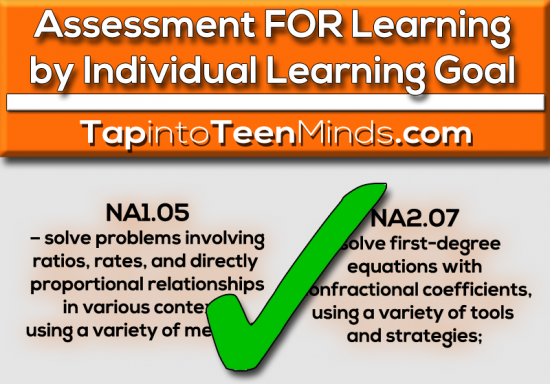
Coming from an educational background in the mathematics classroom where assessment is commonly considered a numbers game unlike subject areas such as Language where assessment can turn into a professional judgement nightmare, I have traditionally created my assessments to align with course expectations and assessed accordingly. Assessing early and often has always been a strategy used in my classroom to ensure that I provide students assessment as learning and assessment for learning opportunities rather than simply monitoring based on the assessment of learning as outlined in the Growing Success document here in Ontario. Having an opportunity to work in 29 different schools across my district through the Middle Years Collaborative Inquiry project, it is clear that a large majority of intermediate mathematics teachers are providing these same opportunities to improve student learning in our system.
What About Professional Judgement?
Determining a report card grade will involve teachers’ professional judgement and interpretation of evidence and should reflect the student’s most consistent level of achievement, with special consideration given to more recent evidence.
Growing Success, p. 39. Ontario Ministry of Education. 2010.
Growing Success references Professional Judgement 14 times throughout the assessment and evaluation guide which really made me reflect on how much I am actually incorporating professional judgement into the final grade of my mathematics students. It seems only natural that math teachers would be most comfortable letting the “numbers do their thing” in order to come up with final grades, but am I assessing all students fairly? Growing Success also states that assessment practices should be:
… ongoing, varied in nature, and administered over a period of time to provide multiple opportunities for students to demonstrate the full range of their learning.
Growing Success, p. 6. Ontario Ministry of Education. 2010.
In my classroom, I have always advertised that no mark was ever final until the completion of the course. Students could take the initiative to address their individual learning needs and demonstrate their understanding through a conversation while modelling this improved learning. Although I had created this strategy to assist students with larger gaps in understanding, most often it was students already achieving at high levels that would take advantage of this opportunity. Some students struggling in a course may not have the same level of motivation as those experiencing success, but what if it was something else?
You Don’t Know What You Don’t Know
Imagine this: You’re in my math class and you’ve been receiving assessments with marks in the 55% to 65% range. I keep telling you that you can always address your learning needs to improve your grade. However, you’re not really sure what it is you don’t get. All you know is: “I don’t get it!”
How can I expect students struggling in a course to get back on their feet if they don’t know what they don’t know?
Breaking Down Assessments: Assessing By Individual Learning Goal
Over this past semester, I have been committed to trying to breakdown my assessments by learning goal or specific curriculum expectation. By doing this, I had hoped to better assist all students to strive for improvement, even after a summative assessment. By making students more cognizant of their level of understanding according to each learning goal, it was my hope that students could address their learning needs in an organized fashion.
While some students have been using this information to improve their mastery of learning goals, I found that some struggling students were able to identify their weaknesses, but were uncertain what they could do to improve. Providing struggling students with resources that are easily accessible and tied to specific learning goals is my plan to address this student learning need moving forward.
Public Google Spreadsheets to the Rescue
Over Christmas Break, I spent some time adding links to resources and content directly in my Learning Goals and Assessment Spreadsheet to provide students with:
- YouTube Tutorial-Style Videos,
- Khan Academy Practice Exercises, and
- Additional opportunities to demonstrate understanding of a learning goal.
A bonus for this course, MFM1P Foundations of Mathematics: Grade 9 Applied, is that it is an EQAO Provincial Assessment year. Therefore, the content added to provide students with additional opportunities to demonstrate their understanding is simply questions from previous EQAO Assessments organized by learning goal. This not only gives students additional opportunities to improve, but it also allows them to get an understanding of the EQAO Test format and build some confidence along the way. Some businesses even use tests like these in order to grade new recruits before meeting them. This is called a psychometric assessment and is a great for finding out a persons behavioual traits before actually meeting with them.
Here is a few screenshots of my Learning Goals and Assessment Spreadsheet created with Google Spreadsheets and made public by student number for easy access:
(NOTE: I made a copy and even removed student numbers to keep student details anonymous, however this is actual data collected throughout this semester)
Google Spreadsheets for Quick Data Collection
Using Google Spreadsheets makes it easy to quickly summarize where each student is in their own learning journey and easily shared or made public for all to see.
Visual Assessment at a Glance for Educator and Students
Very quickly, I can glance at this spreadsheet and determine which Learning Goals we should likely focus on as we prepare for a summative assessment. On days where students have time to work independently, they can quickly determine the areas they should be focusing on to best prepare themselves moving forward.
Resources Tied to Individual Learning Goals
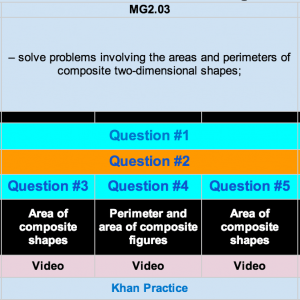 Since students can quickly determine which Learning Goal they must address and have access to videos, Khan Academy Practice, and past EQAO tasks, they can take action immediately without having to search through the course website or digital materials provided in previous classes.
Since students can quickly determine which Learning Goal they must address and have access to videos, Khan Academy Practice, and past EQAO tasks, they can take action immediately without having to search through the course website or digital materials provided in previous classes.
It should also be noted that you can begin to see some patterns regarding which Learning Goals are commonly assessed on the EQAO Assessment by how many questions there are from previous years. Typically, learning goals that have quite a few EQAO Tasks indicate that it is an expectation that encompasses the prior knowledge of other less assessed learning goals. This can be helpful for the teacher and the students as they begin to focus on preparation for their summative assessments in the course.
Seems Like Work… and Reflection
There is definitely some thinking involved in setting up your Assessment by Learning Goals Spreadsheet. However, since curriculum stays fairly constant for some time, I consider it a single investment of your time that will payoff for you and your students for years to come. Updating your spreadsheet can be done with a desktop/laptop, iPad/Tablet, or Smartphone, so you can keep your Learning Goal Spreadsheet up to date on the fly.
I found that implementing this system has really made me re-think how I assess my students and better understand where, when, and how I assess learning goals in the course. For example, I delivered similar assessments as I would have in the past, but found that I was over-assessing certain learning goals and not paying enough attention to others. By continuing this assessment by individual learning goal approach, I think that my assessment techniques will continue to improve and it will allow me to better strategize where I can include learning goals in other portions of the course to better make connections.
Are you using a assessment by learning goal or standards-based grading style in your classroom? I’d love to hear about it in the comments!
WANT TO LEARN HOW TO TEACH THROUGH TASK?

Share With Your Learning Community:

About Kyle Pearce
I’m Kyle Pearce and I am a former high school math teacher. I’m now the K-12 Mathematics Consultant with the Greater Essex County District School Board, where I uncover creative ways to spark curiosity and fuel sense making in mathematics. Read more.
Read More From The Blog

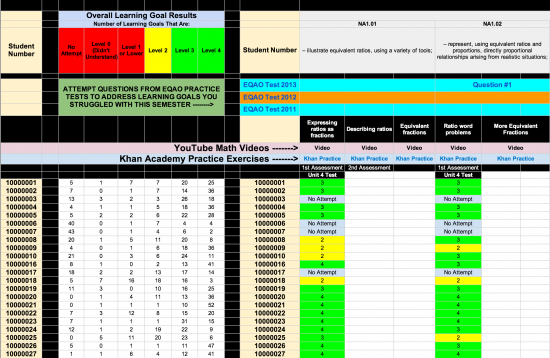
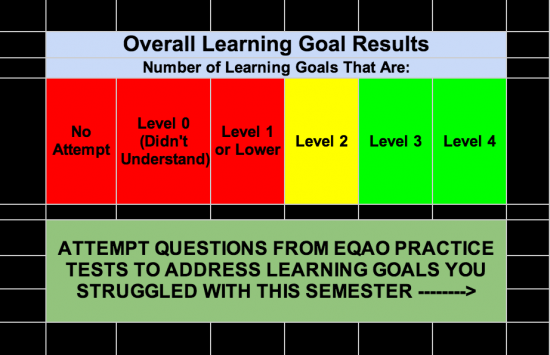
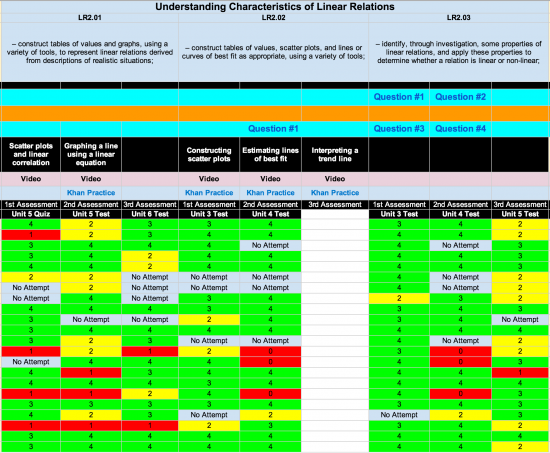
This is an incredible resource you have built. Our district here in Alaska is working towards adopting Individual Learning plans for students based on AK Common Core standards. I can see this spreadsheet being very useful for teachers throughout the district who are finding it difficult to develop the right learning plan. Would it be possible for me to make a copy of your spreadsheet and adjust so it fits the directives of our school district? I would be more than willing to give you full recognition for all your hard work. Thank you in advance.
Thanks for stopping by, Anthony!
I would be more than happy to share a copy of the spreadsheet with you and your district! Drop me a line via the contact page and I can share a copy with you.
Have a great night and thanks for the positive feedback!
Have been thinking and over thinking this for last year and a half. I am working with teachers (I’m a consultant) to define success critera for learning goals and how they tie in with math processes and the achievement chart (AC). Growing Success speaks of co-constructing success criteria. Ss are assessed on the skills that are defined in the AC and thus, this is what we need to define and track in order for them to know where they stand. The engagement comes from having defined with them what success looks like for each skill. So what does Thinking and Investigation look like in Linear Relations for example and are Ss able to identifify artifacts in their work that shows they have acquired such skills? Google forms are then used to track observations and conversations with Ss to document Ts assessment of the skills not to track their ability to finish Q1 to 8. Consequently, headings in these forms are of criteria. Hope this isn’t lost in translation since I work for French Boards in my region.
The problem with me being a consultant is I’m not in the classroom everyday and am not speaking of “real” experience. When I was in class, I didn’t know any better and thought certain questions represented certain skills as modelled by EQAO questions. Success criteria was impossible to identify because this was my stance. Looking forward to going back in the classroom next year to put into practice what I know now.
Would be interrested into continuing this conversation as my thinking continues.
Blogging is my next step but still wondering if I should do it French or in English.
Hi Helene:
Thanks for stopping by and sharing your insight.
Co-constructing success criteria is definitely a great thing and something that I’m hoping to continue improving in my own classroom. It should be noted that the intention for this spreadsheet is not to have students simply complete previous EQAO Questions. This is data that has been collected throughout the semester and the questions listed are simply additional opportunities for students to improve and promote mastery of concepts.
Observations and Conversations are also used for assessment throughout the course and do impact the overall grade of the student.
It should be noted that EQAO questions are created based on Overall Expectations from each strand and not specific expectations as you have mentioned. However, in order to help students better address specific expectations, I have done my best to tie previous EQAO questions to expectations that are best addressed in the question.
This spreadsheet is a new concept, especially having links to resources for students to use, so it will likely remain a “work in progress” for the coming years. My vision for next semester has success criteria and learning goals better represented in student-friendly language.
Hopefully, we can continue to make this idea better over time. Please continue to share your ideas to help make this resource something that is scalable and still manageable for teachers to do in their classrooms.
Cheers! 🙂
I am very very intrigued by this. For the past two years, I had my eighth grade biology students moving completely independently through the set of units that comprise the course. The hardest part was always providing substantive and relevant feedback. This type of thing is definitely something I would want to investigate more.
What have the student said about this process? Is it working for them in terms of supporting their independence.
Gerald:
I love the sound of students being able to work through a course at their own pace. Ideally, I’d like to change my classroom to very little direct instruction in order to achieve something similar. Would like to pick your brain further about this sometime.
Providing feedback could be achieved in a number of ways. This semester, I used another (different) Public Google Spreadsheet to provide students with actual marks and descriptive feedback. I found students didn’t use the feedback as much as I had hoped. Feb 1st marks the beginning of semester 2 and I intend to create a Google Doc in each students’ Google Drive shared folder to take screen shots and provide feedback throughout the course. I have also considered creating video feedback via screencast using Explain Everything or Doceri on iPad or even just with Quicktime on my MacBook Pro. Evernote could be a great option as well to provide feedback to students.
My students seem to like the idea that they know exactly where they are, however as mentioned, I still find that the students who need it most, are typically those who use it the least. We will definitely keep chipping away at it!
Kyle,
I would be happy to talk about the work I did to have students move at their own pace. Let me know when you’d like to do that.
One thing I did with them that was very effective was that each of them complete the weekly progress report. The report was always the same. They answered four questions: 1) what specifically did you do this week?; 2) what specifically did you learn this week?; 3) what are your plans for next week; and 4) what support do you need?
I found over the year that the routine made a difference that the kind of information I got from them allowed me to work with them in very specific to very concrete ways. It also, I believe, was very useful in terms of having them increase their ownership over their own learning. I could take what I learned from the reports and intervene when necessary very specifically and very effectively. Also, the narrative major of their reports about all of this to happen in a conversational manner, which I found to be very effective.
Keep up the good work!
I definitely like the possibility!
Ideally, I’d like to get to a nice mix that would help me best address as many learning styles as possible.
Increasing student ownership of their learning is definitely a student learning need that I think we’d all love to improve. Keep me posted as you progress. I’d be curious to learn more about your observations.
Thanks for the comment and stay in touch!